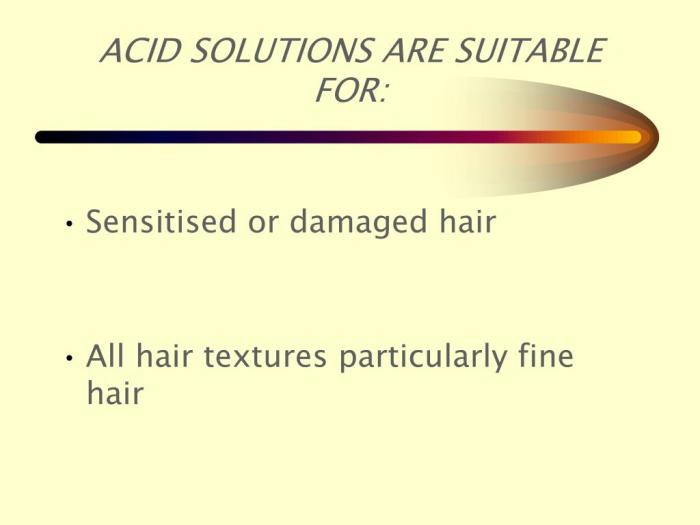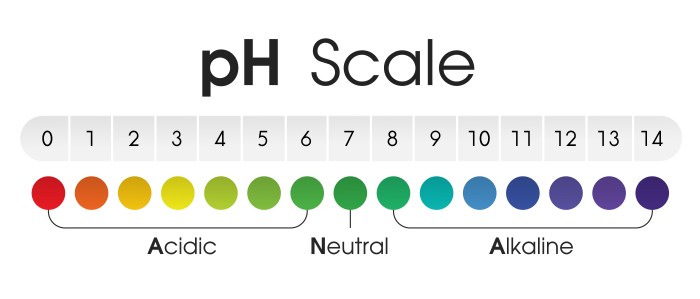Acidic solutions tend to the hair, affecting its structure and properties in profound ways. This discourse delves into the chemical reactions that occur when hair is exposed to acidic solutions, exploring their impact on the hair’s composition and integrity. Furthermore, it provides insights into the preventive measures and hair care tips that can safeguard hair from the damaging effects of acidic solutions.
1. Impact on Hair Structure and Properties
Acidic solutions alter the hair’s pH balance, making it more acidic. This disrupts the hydrogen bonds that hold the hair’s cuticle and cortex together, leading to weaker and more brittle hair.
Effects on the Hair Cuticle
- Acidic solutions cause the cuticle scales to lift, exposing the inner cortex.
- This makes the hair more vulnerable to damage from mechanical stress, such as brushing or combing.
Effects on the Hair Cortex
- Acidic solutions can dissolve the proteins in the hair cortex, leading to breakage.
- They can also damage the disulfide bonds that give hair its strength and elasticity.
Overall, acidic solutions can significantly weaken and damage hair, making it more prone to breakage and other problems.
2. Chemical Reactions in Acidic Solutions: Acidic Solutions Tend To The Hair
When hair is exposed to acidic solutions, a number of chemical reactions occur. These reactions affect the hair’s composition and structure.
Hydrogen Ion Penetration, Acidic solutions tend to the hair
Hydrogen ions (H+) from the acidic solution penetrate the hair shaft, causing the hair to become more acidic.
Dissolution of Proteins
The hydrogen ions react with the proteins in the hair, causing them to dissolve. This weakens the hair and makes it more susceptible to damage.
Disruption of Disulfide Bonds
Hydrogen ions can also disrupt the disulfide bonds between cysteine residues in the hair protein. This weakens the hair’s structure and makes it more prone to breakage.
3. Examples of Acidic Solutions and Their Effects

Common acidic solutions that can affect hair include:
Vinegar
- Vinegar is a weak acid that can be used to rinse hair to remove product buildup.
- However, excessive use of vinegar can damage the hair’s cuticle and make it more prone to breakage.
Lemon Juice
- Lemon juice is another weak acid that can be used to lighten hair naturally.
- However, lemon juice can also be damaging to hair, especially if it is used too often or left on the hair for too long.
Swimming Pool Water
- Swimming pool water is typically treated with chlorine, which is a strong acid.
- Exposure to swimming pool water can damage the hair’s cuticle and make it more prone to breakage.
4. Preventive Measures and Hair Care Tips

To prevent hair damage from acidic solutions, it is important to:
Avoid Overexposure
- Limit the use of acidic products on hair, such as vinegar rinses or lemon juice treatments.
- If you do use acidic products, dilute them with water and rinse them out thoroughly.
Protect Hair from Chlorine
- When swimming, wear a swim cap to protect hair from chlorine.
- After swimming, rinse hair with clean water to remove chlorine.
Maintain a Healthy pH Balance
- Use a pH-balancing shampoo and conditioner to help maintain a healthy pH balance in hair.
- Avoid using harsh shampoos or styling products that can strip hair of its natural oils.
Essential FAQs
What are the common acidic solutions that can affect hair?
Common acidic solutions include lemon juice, vinegar, and certain hair care products like clarifying shampoos.
How do acidic solutions alter the hair’s pH balance?
Acidic solutions lower the pH of hair, making it more acidic. This can disrupt the hair’s natural pH balance, which is slightly acidic.
Can acidic solutions weaken or damage hair?
Yes, acidic solutions can weaken or damage hair by breaking down the hair’s proteins and lipids, leading to frizz, breakage, and loss of elasticity.